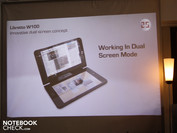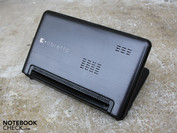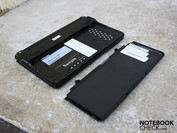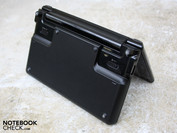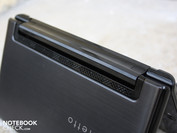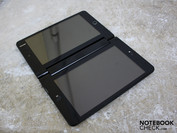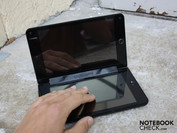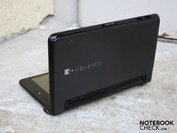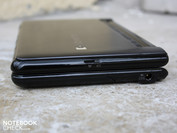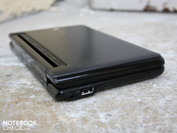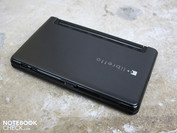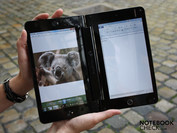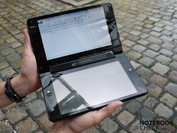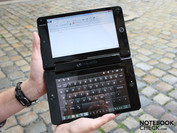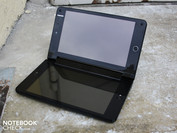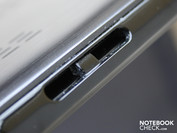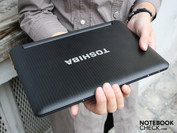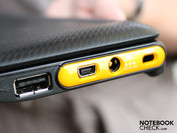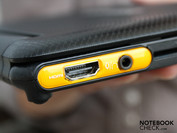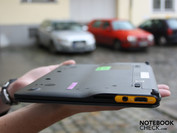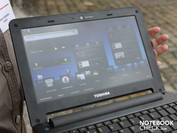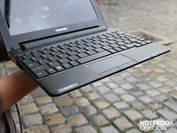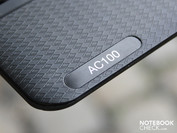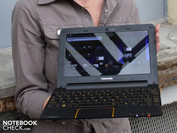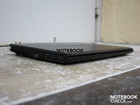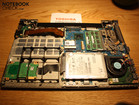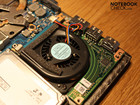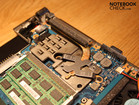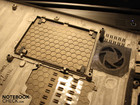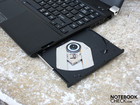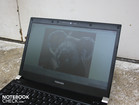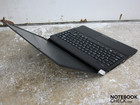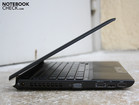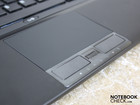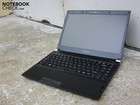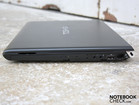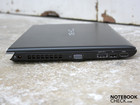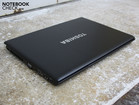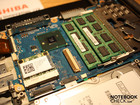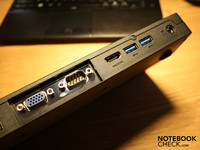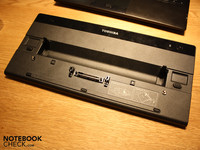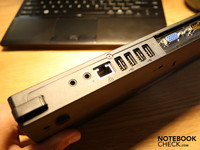NBC Onsite: Toshiba Notebook Special
by Sebastian Jentsch, 06/22/2010
Breaking the Rules?
In 1996 Toshiba belonged to the avant-garde of the netbook hype to first set in years later with its minicomputer, Libretto. Now a refresh, a Dual Touch 7 incher W100, has appeared. Aside from that, the AC100 Cloud Companion is supposed to pair smartphones and netbook and the Portégé R700 provides for an uproar with a competitive price.
Toshiba presented its mobile highlights in Munich/London on June 21st 2010. But neither the consumer series, Satellite, nor the high-end multimedia range, Qosmio, were the center of attention. After Toshiba can look back upon 25 years on the notebook market, the Japanese wants to resume activity with the old spirit of innovation.
Toshiba realizes that the following models are partly daring and don't look suitable for the mainstream. We would like to share our first experiences with the three devices.
Libretto W100: Dual Touch Book
The Japanese design department obviously wants to show what it's capable of. The foldable 7 incher is made with two touch screens (both 102x768) and doesn't have a real keyboard. The name Libretto builds on an 840 gram mini-notebook that Toshiba launched in 1996. The 6.1 incher was very successful and a real high-end product at the time (AMD 486 DX4 to Pentium 233).
The Japanese manufacturer is testing the market on sympathy with a limited amount of the 1099 or respectively 1249 euro expensive Libretto Refreshes. The possibility of creating desire due to a limited availability by technology lovers is very intentional. The manufacturer doesn't state the exact quantity, though. "We found it important to create a unique dual screen notebook that provides the user with a real benefit" says Dirk Thomaere, General Manager Computer Systems Central Europe, about the Dual 7 incher.
The Libretto is technically equipped like a ULV notebook (Pentium U5400, 62 GB SSD). Thus, the rate is sufficient for the use of Windows 7 Home Premium. The pre-series device with a weight of 819 grams was comfortable to handle, but got very warm. The fan, even if very quiet, emitted hot air permanently out of the case. The reason for the warm device is the large amount of waste heat from the components in the subnotebook. Thus, the dual book is considerably more potent than, for instance, Intel Atom netbooks. In return the battery life is shorter. The manufacturer states of only three hours with the 8 cell battery.
The journalists had a heated debate about the benefits of the device. Some called it an overpriced e-reader, others described it as an over-powerful mini notebook with a too short battery life (three hours). Toshiba is aware of the difficultly in classification, but hopes for well-heeled technology aficionados who have fun tinkering.
In any event, the Libretto W100 is versatile. It can be held vertically like a book and thus be used as an e-book reader. This way, for example, two pages of a newspaper can be read. Horizontally, documents can be read on the upper screen, whilst the bottom screen is used for newspaper cuts and brainstorming. But where can you write? The lower screen can be utilized as a virtual, full-sized keyboard. Now, supported by a sensory feedback while typing on the displayed keys (Forced Feedback), you can work with a notebook. A pen input on the screen isn't intended, though. Alternately, it's possible to extend the upper screen over the second one, in order to receive a larger view (1028 x 1200). Contents, documents and symbols are pulled from one screen to the other via drag and drop. A finger action in the direction of the second screen is enough. However, the relatively large gap between both screens in an opened state is annoying in this mode.
Libretto W100-107 without UMTS (SKU PLW10E-00200VGR)
- CPU: Intel Pentium U5400 (1.2GHz)
- Chipset: Intel QS57
- OS: Win7 32bit Home Premium
- Display: Dual-Display: 2 x 7 " WSVGA touch displays (1024x600)
- RAM: 2 GB DDR3 (800 MHz) onboard
- HDD: 62 GB SSD
- Graphic card: Intel GMA HD
- Communication: WiFi / WiFi BT Combo Realtek 802.11 b/g/n (13 channel)
- Separate Bluetooth module: Bluetooth V2.1 + EDR
- High-Speed UMTS -
- Interfaces: 1 USB, Micro SD, web camera HD WebCam (1.280x800) + int. microphone
- Sound Mono
- Adapter: 45W / 19V
- 8 cell 2.460mAh 14.4V Li-Ion
- Weight: 819 g (8 cell battery)
- Dimensions: 202x123x30.7 mm (8 cell battery)
- Case: matt, brushed black
- Warranty: 2 years (pickup & return)
- Features: Toshiba ConfigFree, Eco Utilty, PC Health Monitor
- Price: 1099 euro
- Availability: as of July/August 2010
Libretto W100-10D (SKU PLW10E-00500VGR)
- as above but with high speed UMTS HSPA – 7.2/2.0 Mbit/s (F3607 gw)
- Price: 1249 euro
AC100 Cloud Companion: Something between a Smartphone & Netbook
Assume that all user data is on the internet, i.e. on Google and Facebook? The 10.1 incher, AC100 aka Cloud Companion, is supposed to be the right mini-notebook for these cases. It's not a real notebook, it could at most be called a netbook. Equipped with the NVIDIA Tegra T20 processor (1 GHz, ARM) and the operating system, Android, it's performance is closer to one of the stronger smartphones (but can execute flash). The Toshiba AC100 works with the Android 2.1 system that many smartphone users know.
An oversized smartphone with a netbook keyboard? That's exactly what it's supposed to be – a product somewhere between a smartphone and a netbook. In the gist of cloud computing, the user's content (documents, pictures, music, movies) is placed on web servers and not on the local hard disk. The AC100 consequently only needs enough performance to call up the information. Therefore, the hard disk capacity of 8GB eMMC (embedded multimedia card) will just suffice for the OS and a few tool installations.
That this scenario is not yet a widely spread reality and that the AC100 is looked at skeptically, is something Toshiba knows. The Japanese are nevertheless convinced that the future of internet utilization is moving in this direction. The Cloud Companion is already to be launched onto the market now in order to once again be a technology pioneer. Toshiba doesn't reckon with huge quantities being sold yet.
Naturally, users will already benefit from the AC100. The 10.1 incher is ready to use and online within seconds, the manufacturer promises. The Toshiba AC100 allegedly lasts for up to seven days in standby mode, without having to be recharged. The AC100-10V is the deluxe version, with a 3G HSPA module (449 euro RRP). If you're satisfied to surf at home or in WiFi area, the AC100-10K with WLAN draft-n might be sufficient (349 euro).
The AC100's surfaces and applications can be modified. Toshiba offers numerous pre-installed applications or the possibility of downloading applications and widgets from an APP store. Among the pre-installed applications, you'll find Documents to Go, with which Microsoft Office documents can be viewed and edited. Additionally there is an email program with POP3, IMAP and Exchange support, a program for news, Opera modules an also Toshiba's media player.
The use of Android on the presented sample could be managed quite adequately. Even users set on Windows quickly found the desired functions. Nevertheless, with a price of 350 – 450 euro, the eccentric netbook can't really distinguish itself appealingly from the netbook mass. The device's advantages fade away with a battery life of only about 8h in practical use in comparison to dozens of current netbooks.
The first two models should be available in retail in August 2010.
Toshiba AC100-10V (SKU PDN01E-003016GR) & AC100-10K
- CPU Nvidia Tegra T20
- Chipset: Nvidia Tegra
- OS: Android
- Display: 25.7 cm / 10.1" TruBrite WSVGA Display with LED
- RAM: 512 MB (533 MHz) onboard
- HDD: 8 GB eMMC
- Graphic card: integrated in Tegra chipset
- Wireless communication: Wi-Fi / Wi-Fi BT Combo Ralink 802.11 b/g/n
- High-Speed UMTS High-Speed-UMTS HSPA 7.2/2.0 Mbit/s (F3307)) Not for Toshiba AC100-10K
- Interfaces: HDMI, 1 x USB full size, 1 x USB mini, 2-in1 Bridge Media, 1.3 MP WebCam + Microphone
- Sound: Stereo
- Adapter: 19V / 30W
- Battery: 3 cell Lion 2.200 mAh
- Weight: 870 g
- Dimensions: 262.1 x 189.8 x 14/21 mm
- Design: Diamond structure in sepia with orange accents
- Warranty: 1 year
- Warranty type: Bring in
- 349 – 449 euro
Portégé R700: High-End Light Weight with a Discount
Portégé stands for elegance, robustness and high-quality – so says Jens Böcking from Toshiba, Germany. The R700 is supposed to become the slimmest and lightest 13.3 inch notebook on the European market. The highlight: A weak ULV processor isn't used, but the full range of the strong Intel Core i7, i5 and i3 processors. Because the waste heat of these CPUs can be substantial, Toshiba says it has developed a very effective "Airflow Cooling Technology" together with Intel. Airflow Cooling has a relatively large fan (diameter) in relation to the size. The fan can rotate slower but nevertheless suck in a large amount of cooling air.
However, the notebook will have to prove just how efficient the system is in regards to the interaction of performance, soundscape and temperature development in our tests.
A honeycomb-like interior structure of aluminum-magnesium components (Honey Comb Structure) takes care of the chassis' stability. The notebook is stiffer, despite the low material thickness due to it. We could look at the disassembled R700 extensively. The term "stiff" has to be seen relatively. The R700 is miles away from the torsional stiffness of a MacBook. In return, it also weighs a lot less than its Apple colleague with 1.4 kilograms (with DVD drive). 1.4 kilograms is about the weight of a 10 inch netbook with a strong battery.
Other than previous Portégé new releases, which could easily cost more than 2000 euro, the RRP already starts at 1349 euro (R700-13K) this time, according to Toshiba's last statement. You'll get a i3-350M processor beside a fast rotating 320 GB (7200 rpm) hard disk. A HSPDA module (7.2 Mbps / HSUPA 2 Mbps) is also built in for this price (standard in R700). The battery capacity, however, differs in the models. Toshiba states a runtime up to 8 hours, 55 minutes (Mobile Mark 2007) for the R700-13K. The 1599 euro expensive model, R700-16W (Core i5-520M), is supposed to even last up to 12 hours, 55 minutes.
If this is still too expensive for you, you can take a look at the consumer model, R630. It costs 999 euro (RRP) based on the same chassis and has a Core i5-450M.
Interesting: First prices stated in London (starting at 699.00 euro) obviously can't be kept up with at all.
Portégé R700-16W
- Processor: Intel Core i5-520M processor (2.40 / 2.93 Turbo GHz)
- Operating System: Windows 7 Professional 64-bit + Downgrade to Windows XP Professional (Toshiba-Recovery DVD)
- Display: 33.8cm (13.3-inch) Toshiba HD AR coated, 1.366 x 768
- Hard disk: 320 GB (7.200 rpm) SATA
- Memory: 4096 MB, max. 8.192 MB, DDR3 RAM (1.066 MHz)
- Optical drive: Slim DVD Super Multi (Double Layer)
- Graphic card: Intel Graphics Media Accelerator HD
- Pointing device: Touchpad with multi-touch
- Network: Gigabit Ethernet LAN, Wireless LAN 802.11b/g/n, Bluetooth
- Mobile broadband: WWAN/3G (HSDPA 7.2Mbps / HSUPA 2Mbps) HSPA/UMTS
- Sound: stereo loudspeakers
- Interfaces: VGA , RJ-45, headphone, microphone , multi-cardreader (SD, miniSD/microSD, SDHC, microSDHC. MMC, 2 x USB 2.0, eebcam, microphone, eSATA/USB 2.0 (USB Sleep-and-Charge), HDMI
- RAM expansion (2 slots), Express Card slot (54 mm)
- Battery: Lithium-Ion
- R700-16W & R700-172: Li-Ion, 9 cell, 7200 mAh, PA3636U-1BRL
- up to 12 h, 55 min (Mobile Mark 2007)
- R700-13K: up to 8 h, 55 min. (Mobile Mark 2007)
- Dimensions: 316 x 227 x 18.3 (front) / 25.7 (rear)
- Weight: starts at 1.43 kg
- Warranty: 2 year international Bring-In
- Supplies: Dynadock USB Port Replicator (optional)
- Prices:
- 1.349 euro (R700-13K)
- 1.599 euro (R700-16W)
- 2.299 euro (R700-172)
- Availability: End of August 2010
Deluxe Port Replicator: USB 3.0 upgrade
There is a new docking solution available for the R700. The improvement to the old docking solution: the notebook can now also be connected to the 9 cell battery. The Deluxe Port Replicator also adds USB 3.0 to the desk beside the notebook's ports.





